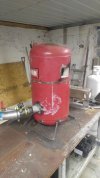- Joined
- Oct 3, 2002
- Messages
- 12,297
Stacey, any reason not to make the entire thing from castable other than the improved insulation of the wool?
Thanks, that makes perfect sense.Castable refractory isn't insulation, it is a refractory that will absorb and evenly hold the heat. It will slowly heat through and the other side will be very hot. It needs a layer of insulation around it to hold in the heat. Once heat soaked, there is no other setup that equals it for evenness of heat. It takes longer to heat up than a 1/4" of satanite, but is worth the wait. The only negative is it add a good bit of weight to a forge, so it isn't suitable for portable units. That isn't usually a problem, and with putting the forge on a rolling cart, the forge can be rolled around as needed.
If you just cast a forge from Cast-o-lite with no jacket of insulation, it would eventually end up glowing on the outside if it ran long enough.
I will also comment that I always say to "coat with ITC-100", but in the case of a cast liner, I don't think it really does much ( or nothing).
It is a blown burner, there is no orifice.
2500 refractory would be fine for forging, but insufficient for making damascus. You really need 2800 or higher.
Just to explain, while the welding temperature for damascus may be 2350-2400, the chamber is exposed to flames at higher temps. 2500 just won't hold up long.

Ok here it is. This thread convinced me to abandon, or at least postpone the horizontal ribbon forge I was building. Tonight I test fired my new craftsman vertical forge. Cast floor, 2" wool, forced air burner.
Holy crap this thing makes more heat at 3 psi and partial opening of the needle valve than my significantly smaller 2 burner venturi forge did at 20 PSI and wide open. Still some finishing touches but I am a believer!
View attachment 757869
